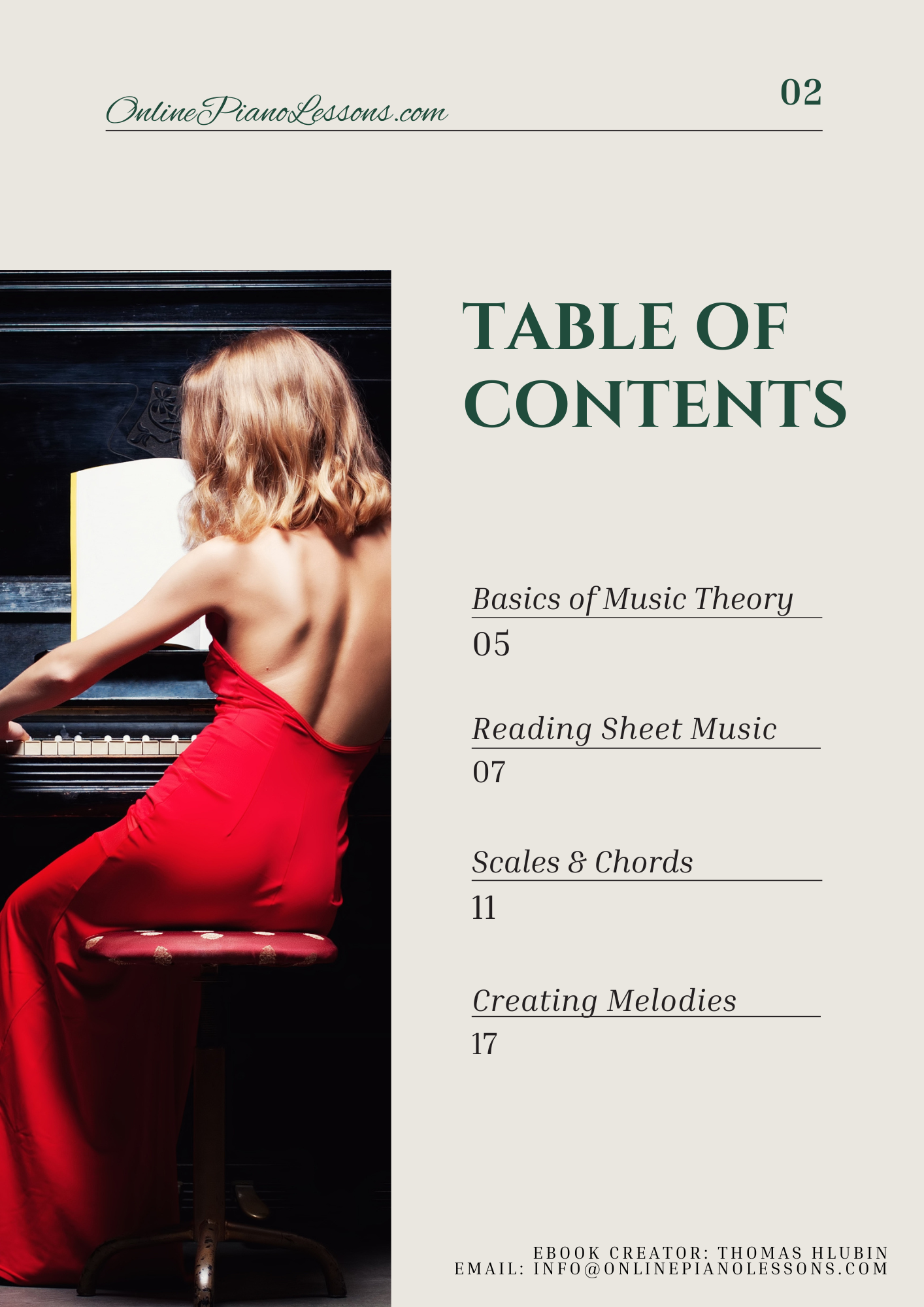The pentatonic scale is one of the most useful and accessible musical tools a pianist can learn. On the piano, pentatonic scales produce instantly musical-sounding melodies, forgiving improvisation zones, and global flavors—from folk tunes to modern pop hooks. This definitive guide explains what pentatonic scales are, what they sound like, how to find them on the keyboard, why they’re so important, and practical ways to use them in practice, composition, and improvisation.
What Is A Pentatonic Scale?
A pentatonic scale is any five-note scale (penta = five). On the piano the two most common pentatonic scales are the major pentatonic and the minor pentatonic. The major pentatonic scale removes the 4th and 7th degrees from the major scale; the minor pentatonic removes the 2nd and 6th from the natural minor. Because they skip certain half-step relationships, pentatonic scales sound open, consonant, and easy to use—especially on the piano where every note in the scale generally fits cleanly over simple accompaniments.
The Two Core Pentatonic Scales
- Major pentatonic formula (relative to root): 1 — 2 — 3 — 5 — 6.
Example on piano in C major pentatonic: C — D — E — G — A — C. - Minor pentatonic formula (relative to root): 1 — ♭3 — 4 — 5 — ♭7.
Example on piano in A minor pentatonic: A — C — D — E — G — A.
Because these pentatonic scales avoid half-step clashes, melodies built from them almost always sound pleasing. That’s why the pentatonic scale shows up in children’s songs, blues licks, folk music, and contemporary piano improvisation.
What The Pentatonic Scale Sounds Like On The Piano
On the piano, the pentatonic scale sounds both simple and evocative. The major pentatonic scale feels bright and open—useful for cheerful themes, folk melodies, and pop hooks. The minor pentatonic scale has a bluesy, soulful quality and forms the backbone of countless rock and jazz licks when adapted to the piano.
Play a C major pentatonic scale slowly and you’ll hear a relaxed, singable line that avoids tension. Play an A minor pentatonic and you’ll feel the bluesy pull—plenty of melodic possibility without harsh dissonance. That musical safety is why pianists love pentatonic scales as improvisation scaffolding.
How To Find Pentatonic Scales On The Piano
There are simple visual and interval tricks to find pentatonic scales on the piano:
- Major pentatonic: start on any root, then move up a major second, major second, minor third, major second, minor third (1–2–3–5–6). On the keyboard you’ll skip the white key that would be the 4th and the 7th in a major scale. In C: play C, D, E, G, A.
- Minor pentatonic: start on any root, then move up a minor third, whole step, whole step, minor third, whole step (1–♭3–4–5–♭7). In A: play A, C, D, E, G.
A quick visual trick on the piano: many pentatonic scales can be played using mostly the black keys (for certain transpositions), which is why they’re so comfortable for beginners. But you can play pentatonic scales starting on any note, and they’ll feel natural quickly.
Why Pentatonic Scales Matter (Especially On Piano)
- Instantly musical: The pentatonic scale avoids dissonant half-step clashes, so almost every melodic combination sounds pleasing on piano.
- Great for improvisation: When you’re learning to solo on piano, using a pentatonic scale reduces the chance of hitting a “wrong” note.
- Global and stylistic: Pentatonic scales appear in blues, rock, classical folk, Asian traditional music, and more—so learning pentatonic scales makes it easier to play across styles on the piano.
- Composition shortcut: Simple, memorable melodies often come from pentatonic scales; many pop hooks and film motifs are pentatonic-based.
- Ear training: Practicing pentatonic scales helps your ear recognize consonant intervals and build melodic phrasing quickly.
Practical Exercises For The Piano
Start with these hands-on drills to internalize pentatonic scales on the piano:
- Warm-up: Play one-octave major pentatonic and minor pentatonic scales in C and A, hands separately then together.
- Patterns: Play three-note and four-note sequences within the pentatonic scale (e.g., 1–2–3, 2–3–5, 3–5–6) to build finger comfort and melodic ideas.
- Arpeggio practice: Outline the implied triads in the pentatonic scale (C–E–G and A–C–E shapes) to link harmony to melody.
- Improv loop: Set a simple one-chord vamp (e.g., C major) and improvise using the C major pentatonic scale. Record and repeat.
- Transposition drill: Take one short pentatonic phrase and move it through all 12 keys — pentatonic scales transpose cleanly and this builds keyboard geography.
Ten minutes per day on the pentatonic scale drills yields fast results.
Pentatonic Scales And Harmony On The Piano
Although pentatonic scales are often taught as melodic tools, they also suggest harmony:
- Over a major chord, the major pentatonic scale provides stable chord tones (1, 3, 5) plus friendly additions (2, 6). On piano, simple accompaniment patterns (root and fifth in the left hand) pair perfectly with major pentatonic melodies in the right hand.
- Over a minor chord, the minor pentatonic scale highlights the characteristic minor third and fifth while providing passing tones (4 and ♭7). Pianists frequently use pentatonic scales to create voicings that feel harmonically “safe” while sounding expressive.
Use chordal drones or simple two-note left-hand ostinatos to let pentatonic melodies sing on top — it’s an easy way to make compelling piano tracks.
Using Pentatonic Scales Creatively
- Songwriting: Build a memorable motif using a pentatonic scale and repeat it with rhythmic variation.
- Layering: Combine major and minor pentatonic fragments for color. For example, overlay A minor pentatonic phrases over a C major vamp (they share many notes).
- Modal flavor: Use pentatonic scales to evoke folk or world-music vibes—try G major pentatonic for Celtic flavors or E minor pentatonic for bluesy lines.
- Teaching beginners: The pentatonic scale is an excellent first scale for new piano students because it reduces the fear of “wrong” notes and encourages improvisation.
Common Mistakes And How To Avoid Them
- Staying in one box: Don’t only play up-and-down scale runs—use pentatonic scales to create motifs and call-and-response.
- Ignoring harmony: While pentatonic scales sound good alone, they become far more musical when paired with clear chord support on the piano.
- Over-simplicity: Pentatonic scales are simple, but that simplicity can be elevated with rhythm, dynamics, and space—don’t play mechanically.
Why Teachers Love The Pentatonic Scale
Piano teachers often use pentatonic scales early because they promote creativity, ear development, and confidence. Students who start improvising with pentatonic scales tend to remain engaged and progress faster when eventually learning more complex scales. The pentatonic scale’s forgiving nature makes it one of the best gateways into musical phrasing on the piano.
Final Thoughts
Pentatonic scales are deceptively powerful: five notes, endless musical possibilities. On the piano they provide a fast track to improvisation, songwriting, and expressive playing. Take your time and learn the shapes, practice the exercises, pair the pentatonic scale with simple chords, and most importantly—have fun!
FAQ
Q: What is the difference between a pentatonic scale and a major/minor scale?
A: A pentatonic scale has five notes instead of seven. The major pentatonic removes scale degrees that create half-step tension; the minor pentatonic similarly omits two notes. On piano this reduces dissonance and makes melodies sound immediately pleasing.
Q: Can I improvise over any chord with a pentatonic scale?
A: Yes, pentatonic scales are highly forgiving. Major pentatonic works well over major chords; minor pentatonic over minor or bluesy contexts. Some pentatonic phrases even work over modal or ambiguous harmony on piano.
Q: How do I find a pentatonic scale on the piano?
A: Choose a root and apply the formula: major pentatonic = 1, 2, 3, 5, 6; minor pentatonic = 1, ♭3, 4, 5, ♭7. Play those notes on the keyboard and explore patterns.
Q: Are pentatonic scales used in professional music?
A: Absolutely. Pentatonic scales appear in blues, rock, jazz, folk, pop, film scores, and world music. Many famous melodies and solos are pentatonic at heart.
Q: Which pentatonic scale should beginners learn first on piano?
A: Start with the major pentatonic (e.g., C major pentatonic) for its bright, open sound, then learn the minor pentatonic (e.g., A minor pentatonic) to explore bluesy textures.







 Hi, I'm Thomas, Pianist Composer,
Hi, I'm Thomas, Pianist Composer,  I love playing piano, creating new melodies and songs, and further developing my online piano course and making updates/additions to my site OnlinePianoLessons.com!
I love playing piano, creating new melodies and songs, and further developing my online piano course and making updates/additions to my site OnlinePianoLessons.com!  Now that is what I call fun!
Now that is what I call fun!
